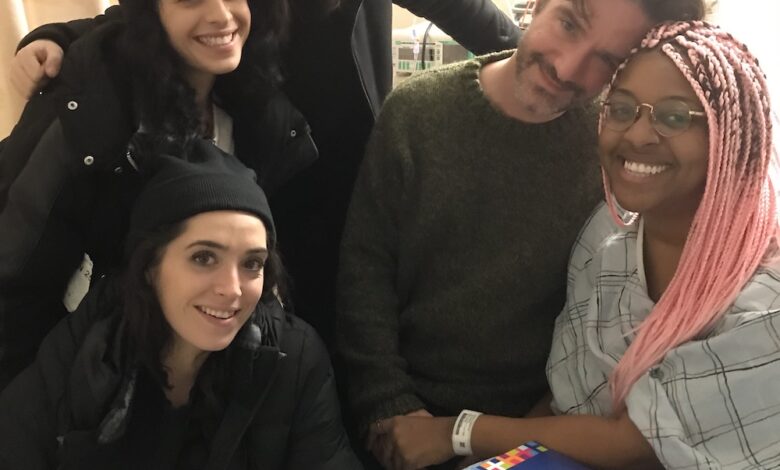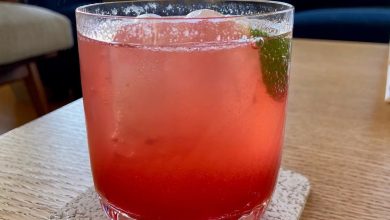Thank God for Women of Color

Kim in the hospital, visited by her friends and boyfriend, in 2019.
It was Christmas morning 2019, and I wasn’t feeling well. I was spending the holiday with my parents in Oklahoma and had been complaining of shortness of breath and slight chest pain all week. I chalked it up to anxiety. But by the time I got to the airport four days later, I knew something was terribly wrong…
My shortness of breath turned into heaving gasps after walking just a few feet through the airport; I shuffled the rest of the way to my gate. I landed in New York that night and immediately went to the ER. I was still convinced it was just anxiety, adding it to the list of bizarre symptoms I’d collected over the years. I’d never stayed in the hospital for anything. Even my parents had no hospital visits, so the idea of something being wrong with my body was unthinkable. I was finally seen by someone around 1 a.m. The nurse was stern but very caring. “Right, so we did a blood test and you’re either having a heart attack or you have blood clots.” My mind went blank. WHAT?? I don’t have a blood clot! I just need a Xanax, I thought. But after another test, it was confirmed that I had a blood clot in one of my lungs, which explained the heavy breathing.
The nurse started asking questions that might indicate the cause:
“Have you flown on a plane recently?”
“Yes.”
“Are you on the pill?”
“Yes.”
“Ok. You’re gonna have to stop taking the pill, immediately. You’re really young, and since you don’t smoke, I’m going to take a wild guess and say it’s either the plane or the pill.”
I was in disbelief. How could this be? I needed a CT scan to see the size of the clots, and as I followed the doctor past rows of hospital beds into the next room, I doubled over again, unable to breathe. She put her hand on my back and said, “This is worse than I thought.” With tears rolling down my face, I lay on the hard plastic tray as warm dye filled my veins, illuminating the clots in my lungs.
An hour later, the warm and cheerful CT tech walked in and announced, “Wow, you’re an overachiever! You actually have two clots — one in each lung. We call that a bilateral pulmonary embolism.” The clots were huge and putting strain on my heart. An EKG tech would come by in the morning to look at the blood flow. My mind was reeling, and as they placed me in the critical section of the ER with a Heparin drip, I tearfully called my parents and texted my best friend Leslie, a nurse who made sure I advocated for myself. I drifted off to sleep at around 7 a.m. This wasn’t supposed to happen.
The next five days were a blur, as I was transferred to another hospital, more well equipped to handle my case. A team of three young doctors came to visit me every day to update me on my progress. “And you don’t smoke?” the first doctor asked, scribbling a note. “Nope,” I answered for the billionth time. “But you’re so young. It’s weird that you’d have blood clots at this age. Anyway, you should be out of here by New Year’s Eve!” The smiling doctor left the room, giving me a wink while the other two doctors fell back. “Actually…” they started as soon as the first doctor left the room, “your numbers are still very high, and you probably won’t get out by New Year’s Eve. We want to keep you as long as we can to make sure you’re absolutely safe.”
At the time, I was frustrated. All I wanted to do was forget these traumatic last few days and celebrate the new year with my boyfriend. But I should have realized that the two doctors who stayed in the room were looking out for me. The peppy doctor who’d given me a sunny diagnosis was a white man, and the other two doctors were women of color. My doctor and nurses at the first hospital were Black women and an Asian woman. They all had my back and at the time I hadn’t realized how lucky I was. It made me think of advocate and model Mama Cax, who had just died of a pulmonary embolism, not one week before I went to the ER, and Serena Williams who had to demand — more than once — that she get a CT scan for a pulmonary embolism after nurses refused to listen to her.
I took going to the doctor and assuming whoever was assigned to me would treat me fairly for granted.
According to a 2016 study, 50 percent of medical students and residents believed Black people couldn’t feel pain the same way white people do, because they had thicker skin or their nerves didn’t work the same way. Black people also have a 30 to 60 percent higher chance of developing a pulmonary embolism than white people. I left the hospital later that week knowing that because of those two doctors, I had been checked ten times over before I was cleared to leave.
Fifteen months later, I’m almost on the other side. After a year of taking blood thinners, I have no more blood clots, and I’m seeing doctors to confirm the cause. I’m still dealing with a few who wave off my concerns, and at first I thought, Well, they’re the experts. Maybe I should just listen to them. But no one knows my own body the way I do, and I’ll keep going until I find the right doctors who hear me. I never forget how lucky I am just to be alive, even when dealing with doctors who might’ve believed I was suffering less than I was or that I was making it up. I do it for the long healthy life I’ll have, and the lives cut short because they were ignored.
P.S. How I feel right now as a Black woman and becoming anti-racist.
(Photo from Kim Rhodes/Instagram.)






